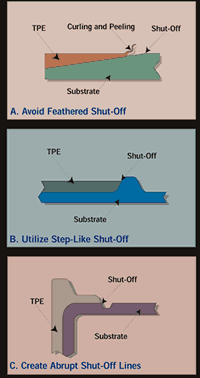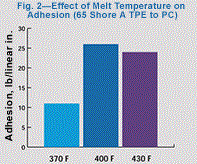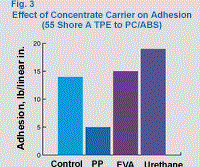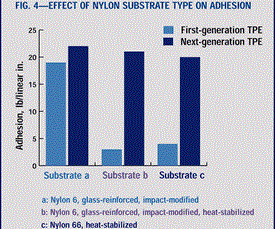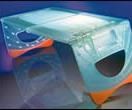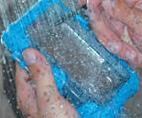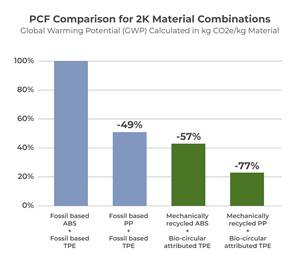How to Optimize Adhesion in Hard-Soft Overmolding
Over the past decade, soft-touch overmolding has radically changed the look, feel, and function of a broad range of consumer products.
Over the past decade, soft-touch overmolding has radically changed the look, feel, and function of a broad range of consumer products. Abundant new color, texture, and tactile options are available in such products as toothbrushes, razors, power tools, cameras, kitchen items, hand-held electronics, and auto-interior parts.
Driving this change is the increasingly diverse range of thermoplastic elastomer (TPE) materials. In overmolding, a TPE is injection molded over or around a compatible substrate using either insert or multi-shot processes. The resulting hard-soft structures are quite effective in comfortable, non-slip, and abrasion-resistant handles, grips, and buttons.
A critical challenge for designers and producers of these parts is poor adhesion of TPE to substrate, which reveals itself in peeling, curling, fraying, or delamination of the material layers. Initially, this was a fairly straightforward issue since the most common approach was to combine an olefin-based TPE with a compatible rigid PP substrate.
In recent years, however, the range of materials used in overmolding has expanded significantly to include more TPE classes (e.g, TPU, TPV, SEBS) and a broader range of substrates (ABS, PC, and nylon). While the broader materials spectrum for overmolding expands opportunities for soft-touch design, it also adds new levels of complexity and poses new challenges in adhesion.
A toolbox of remedies
In insert molding, the rigid substrate is molded first and transferred to a second mold, where a TPE is shot around the insert to create the finished part. The process uses standard injection molding machines and relatively simple, low-cost tools. Insert molding is best suited to applications involving relatively low volumes and manufacturing locations where labor costs are low.
Multi-shot molding requires a special press with multiple barrels that allow several materials to be shot into the same mold. (Most often, such parts use two-shot molding, but some parts require three or four shots.) Benefits are reduced overall production time, superior part quality, and lower labor requirements. The approach is economically viable in programs of 250,000 parts/yr or more and regions where labor costs are high.
In both processes, strength and durability of adhesion between TPE and substrate require compatible hard and soft materials. The type of overmolding method used also affects adhesion performance: Multi-shot molding, by bringing together several melt fronts, generally offers superior adhesion. Adhesion performance is also affected by a number of additional factors:
• Shut-off design: Design of the transition, or shut-off, area between the TPE and substrate is critical to adhesion. Designs should avoid “feathering,” or gradual thinning of the overmolded TPE. Thin layers cause inadequate bonding and can result in curling or fraying of the TPE layer at the tapered edges (see Fig. 1A).
The best antidote is a shut-off design that creates a sharp transition between TPE and substrate. Ideally, a uniform TPE layer thickness of around 0.04 in. is desirable for good adhesion, but that is not always feasible.
One solution is to incorporate a “step” in the substrate profile to create an abrupt transition between TPE and substrate (Fig. 1B). Alternatively, the substrate might include an indentation, with the shut-off designed to put the TPE flush against the substrate (Fig. 1C). Both approaches reduce feathering, neutralize curling, and eliminate tear points that might initiate fraying.
In a few cases (e.g., parts with exceptionally long flow paths or highly wear-prone areas), features are designed into the substrate to create a mechanical interlock after overmolding with TPE.
• Vent design: Air entrapment in the cavity during TPE overmolding is also detrimental to adhesion and is best addressed by adequate venting in the tool. Insufficient venting can show up as poor adhesion at the end-of-flow points, scorching of the TPE, or even short shots. Typical vent depths are between 0.0005 and 0.001 in. The right vent depth for a given part depends partly on the flow properties of the TPE involved.
• Substrate preparation: Proper preparation and handling of inserts is critical to adhesion performance. The cleaner the insert, the better the bond. The optimal production method is to overmold inserts directly after they are produced, since that minimizes chances of contaminants collecting on the insert surface. If storing inserts is unavoidable, they should be scrupulously protected against dust or dirt. Those who handle inserts should wear gloves, since skin oil can impair adhesion. Also, mold releases are best avoided since they seriously impair bond strength between TPE and substrate.
Preheating inserts prior to overmolding often improves adhesion strength. The extent of improvement depends on the degree of compatibility between insert material and TPE. The appropriate insert temperature depends on the substrate and TPE and is best determined through discussions with the materials suppliers.
• TPE melt temperature: The relationship between temperature of the TPE melt and adhesion strength is reflected in the example of a 65 Shore A TPE overmolded on a PC substrate (Fig. 2). As the melt temperature increases from 370 F to 400 F, a notable improvement in adhesion strength is evident. But a further increase to 430 F actually reduces adhesion strength. In this instance, the optimum melt temperature is somewhat less than 400 F. Molders must balance desired adhesion strength against the possible adverse effects of elevated melt temperature, e.g., thermal degradation and ejection difficulty.
The best way to reach the optimal TPE melt temperature is to approach it gradually, not necessarily by increasing barrel temperature, but via higher screw rpm or injection speed. A problem in determining the actual melt temperature is that it is not always equivalent to injection nozzle temperature. A sensible approach is to use a pyrometer to measure melt temperature of a TPE air shot.
Selecting a target melt temperature for the TPE depends on the substrate and the adhesion level required. Most TPE suppliers provide a recommended range of melt temperatures for their products. For maximum adhesion, aim towards the upper end of the supplier’s recommended range.
• “Feel” versus thickness: The tactile feel of an overmolded part is the sum of several factors, just one being the inherent softness (Shore A durometer) of the TPE. Part feel also depends on the TPE’s coefficient of friction, texture, and—most notably—wall thickness.
Where the TPE layer is less than 0.060 in. thick, the feel of a soft elastomer can easily be negated by the hardness of the underlying substrate. The degree of cushioning provided by a TPE layer is also greatly influenced by the substrate’s inherent hardness.
Moreover, thickness of the TPE layer also affects adhesion strength. Thin TPE layers tend to surrender heat rapidly in the cold cavity, and the drop in temperature tends to reduce bonding strength. The challenge for the designer is to strike a balance between the durometer and thickness of the TPE to achieve the cushioning level desired.
• Predrying: Some TPE types—including TPU, TPV, and copolyesters—tend to be hygroscopic, or prone to moisture pick-up. If not appropriately dried prior to molding, absorbed moisture can turn to steam and harm adhesion at the interface of the two materials. Moisture also can hydrolyze some resins, harm surface properties, and increase ejection difficulty. Moisture at the time of molding generally should not exceed 0.05% by volume. Common practice is to dry TPEs in a desiccant dryer with a –40 F dewpoint.
• Concentrate carrier compatibility: Overmolding with TPEs containing color concentrates can be tricky, one danger being conflict between the colorant carrier and the TPE. The workhorse carrier for TPEs has long been PP, but this carrier frequently performs poorly when bonding certain TPE families to nylon, PC/ABS, and other engineered substrates.
This is illustrated by adhesion data for a 55 Shore A TPE containing a color concentrate and overmolded on a PC/ABS substrate (Fig. 3). In this case, a PP concentrate carrier exhibits adverse effects on adhesion, apparently because of a conflict between the carrier and the TPE. In contrast, data show that with this particular TPE, EVA and TPU carriers provide superior adhesion.
• Gate design: In parts that are subject to high wear during use, and consequently prone to layer delamination, gates should be positioned in the areas that will receive highest wear. That’s because TPEs are hotter (and thus generally adhere better) at the gate rather than at the end of flow. When appearance is a priority, as in cosmetics packaging, gating from the back of the substrate via a pin is preferred since it hides gate blemishes on the TPE.
To ensure that the TPE melt adequately fills the mold cavity, a key consideration is the ratio between flow length and part thickness. The minimum ratio should be around 150:1. Another proven approach is to locate the gate at the thickest area of the part and to keep flow length as short as possible.
In selecting a gating method, it is advisable to begin with a “steel-safe” design of the gates and to size them initially on the small side, enlarging them later as required. Certain TPEs (like SEBS) require a smaller gate to boost shear and ensure complete mold fill. Other TPEs (TPVs and TPUs) generally require larger-than-normal gates to compensate for their high melt viscosity.
More tips on tooling
Adhesion is not the only important consideration in overmolding, so here is some advice on aspects of tool design that will optimize other areas of performance:
• Surface texture: Designers are sometimes tempted to underscore the texture and grip properties of a TPE by polishing the mold to add a smooth finish. Yet a smooth finish sometimes actually highlights flaws like knit lines and blemishes in the part. Conversely, texturing of part surfaces is often effective in hiding flaws and imparting a “grippy” or leather-like feel. Certain textures have the effect of imparting a harder or softer feel than might be anticipated in light of the TPE’s Shore A durometer. The goal is to balance the surface texture and durometer values of the TPE to get the intended product feel.
• Ejection efficiency: Part ejection can be facilitated by designing 0.5° to 1° of draft into each side of the mold. With more ejection-resistant materials like TPUs, a 5° to 6° draft is sometimes required. Texturing the tool surface frequently improves ejection, whereas a more polished surface tends to impair it.
Tackling nylon adhesion
Nylon-based materials are an increasingly popular substrate in several high-growth overmolding markets—handles and grips for power and hand tools, appliances, and lawn/garden products. The downside is that nylons are often difficult to overmold with good adhesion. TPEs bond relatively well to unmodified and glass-filled nylons, but fall short when joined to versions that are highly formulated with additive packages.
Another problem is the broad array of available nylons, which differ by resin class (e.g., nylon 6, 66, and 12), reinforcement type and loading, and additives used. In the case of a first-generation TPE, test data show that a dramatic loss of adhesion strength occurs when it is bonded to impact-modified and heat-stabilized nylon 6 (Fig. 4). But progress is being made: Data show that a second-generation, improved-adhesion grade of the same TPE class yields significantly improved adhesion performance, even with heat-stabilized products.
Additional considerations also make nylon adhesion more difficult. One is their propensity for high moisture pick-up, which makes careful drying imperative. And the melt temperatures of nylons are higher than for most other substrates, so the TPE melt temperature has to be increased accordingly to ensure good bonding. Preheating of nylon inserts is also generally advised.
In addition, careful selection of color concentrate carriers is needed to ensure good TPE adhesion to nylons. In general, LDPE and EVA are preferred carriers with nylon substrates.
Related Content
More Sustainable Two-Component Overmolding
Swedish compounders HEXPOL TPE AB and Polykemi AB have collaborated on a 2K sustainable development project for consumer products.
Read MoreMilacron’s Massive Booth Highlights Multiple Brands
NPE2024: Coinjection of postconsumer resin, in-mold decoration, LSR micromolding and bioplastics processing are just some of the machine displays at Milacron's booth.
Read MoreCoinjection Technology Showcases Recycled Material Containment
At Fakuma, an all-electric PXZ Multinject machine sandwiches a black core made of mechanically recycled PC/ABS within an outer layer made of chemically recycled ABS.
Read MoreArburg Open House Emphasizes Turnkey Capabilities
Held at the company’s U.S. headquarters in Rocky Hill, Connecticut, the event featured seven exhibits, including systems that were designed, sourced and built in the U.S.
Read MoreRead Next
See Recyclers Close the Loop on Trade Show Production Scrap at NPE2024
A collaboration between show organizer PLASTICS, recycler CPR and size reduction experts WEIMA and Conair recovered and recycled all production scrap at NPE2024.
Read MoreFor PLASTICS' CEO Seaholm, NPE to Shine Light on Sustainability Successes
With advocacy, communication and sustainability as three main pillars, Seaholm leads a trade association to NPE that ‘is more active today than we have ever been.’
Read MoreMaking the Circular Economy a Reality
Driven by brand owner demands and new worldwide legislation, the entire supply chain is working toward the shift to circularity, with some evidence the circular economy has already begun.
Read More




